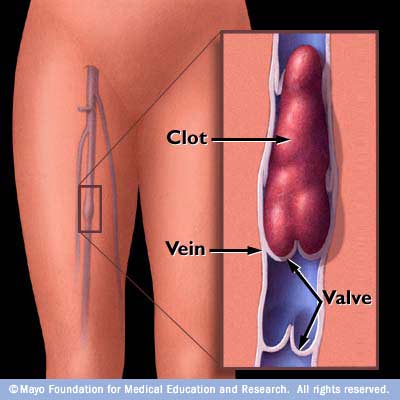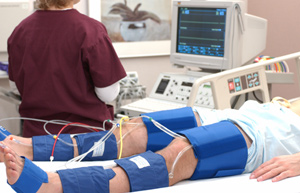Leg Edema Treatment Austin | Leg Ankle Foot Swelling
What is Causing My Lower Extremity Leg Swelling?
Leg Edema Evaluation & Treatments in Austin Texas
Definition of Lower Extremity Edema / Swelling
Lower extremity swelling is known by the medical term “edema.” Edema is the pathological process of fluid or water building up within the soft tissues of the leg, including the skin, fat, and muscles of the lower extremity. Edema most commonly occurs it the lowest parts of the legs, particularly the ankles, as a result of gravity effect. But it can affect any part of the leg or foot or the entire leg or foot. Patients who suffer from lower extremity edema / swelling tend to report that their legs or feet will swell worse as it gets later in the day or when they are on their feet for prolonged periods of time. The swelling tends to improve throughout the night when the legs and feet are elevated, so that the swelling tends to be much less when they awake in the morning. People with the condition begin to notice that their shoes, socks, or clothes begin fitting too tight as a result of the increased size of their extremity. The condition can affect just one leg or one foot, or affect both extremities at the same time. Sometimes one leg or foot has worse swelling than the other. Patients with edema often report a feeling a heaviness, tightness, dull aching discomfort, or tingling / numbness in the involved leg or foot. Sometimes their is no discomfort, just the visible change in the size of the leg. Patients also report that when they remove their shoes or socks, that their is a visible indentation or mark on their leg or ankle where the tissues transition from an area of more prominent swelling to an area of less prominent swelling. It is common to develop some discoloration of the skin as a result of the edema swelling, most commonly a slight pink or red discoloration of the skin or even a dark brown discoloration of the involved skin.
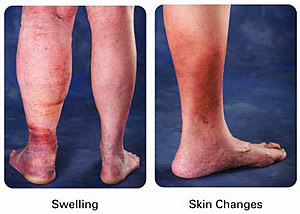
Symptoms of Edema of Leg / Foot
Over 4 million people in the United States (about 1.6% of the population) suffer from lower extremity edema. Symptoms of edema include visible enlargement of the leg / foot, pain, skin discoloration (red, pink, purple, blue, or tan), tenderness of the leg, increased warmth or redness of the skin, “tightening” of the skin, heaviness of the leg, imbalance, or difficulty walking. Patients with severe edema can go on to develop skin blisters or even open wounds or ulcers of the legs, ankle, or foot. Sometime fever can result if the skin gets an infection. There is a higher risk of skin infections in patients with edema.
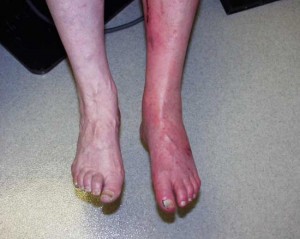
Cause of Lower Extemity Edema of the Leg / Foot
The etiologies of leg edema are multiple are there is a very long list of possibilities. Some of the more common causes include include kidney problems (kidneys are designed to rid your body of excess fluid), circulation diseases such as blood clots or venous valve insufficiency, heart problems such as congestive heart failure or arrhythmias, prolonged immobilization (such as during prolonged travel), surgery, physical trauma, pregnancy, medications such as hormone therapy, obesity, cancer, vein catheters, May-Thurner’s Syndrome, advanced age, lymphatic system damage, and infections. It can sometime be something as simple as salt retention from too high of salt intake in the diet (when you retain salt you also retain water). Also, normal physiologic hormone fluctuations can cause cyclic fluid retention, particularly in women who have constant fluctuations in their hormone levels throughout the month or those that have thyroid disorders. There are also many prescription and over-the-counter medications that can have edema as a potential side effect.
Also, any dysfunction in a major organ (no matter how mild) can throw off the balance of your body’s normal fluid balance and cause an accumulation of excess fluid in your tissues. This can include any problem with the heart, kidneys, liver, blood vessel, or thyroid gland, or adrenal gland. Any hormone imbalance in your body could also cause edema to accumulate in your legs. Since gravity will always carry the fluid to the lowest part of your body, it is usually first becomes evident in the lower legs or feet.
Vein malfunction / vein dysfunction is also another common cause of leg swelling. Veins are the blood vessels in the legs that are designed to carry blood out of the legs and back to the heart (they fight gravity). When veins stop working correctly, the blood “backs up” in the leg veins and leads to pressure build-up and swelling of the legs. The reason that veins usually stop working is because of weakened valves within the veins. As vein valves begin to break, the valves can no longer adequately fight gravity flow. As a results, venous blood begins to travel backwards within the veins. This condition is known as venous insufficiency or venous reflux disease. This vein valve diseae is a common reason that people develop leg or ankle swelling. Vein valve disease can lead to varicose veins as well. Vein valve dysfunction can be an inherited condition or it can be caused by blood clot damage or trauma to the veins.
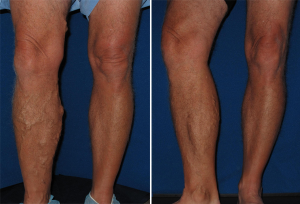
Lymphedema is another cause of leg or foot swelling. It is caused by damage to the lymphatic immune system. The immune system is a network of small spider-web sized channels that carry a water consistency fluid. This watery fluid, called lymph, contains many types of immune system cells. Lymph circulated throughout the body, including the legs and pelvis. When the immune system is functioning normally, many gallons of lymph fluid are circulated through the legs and pelvis every day. When either the lymph channels or their connecting “depots” known as lymph nodes are damaged, lymphedema swelling can occur. Some known causes of lymphedema are infections, trauma, surgery, or cancer. There are also some form of lymphedema that are called primary or idiopathic lymphedema, the cause of which is often unknown.
One of the more dangerous causes of leg or foot edema / swelling is blood clots within the veins (known as Deep Venous Thrombosis or DVT). Blood clots can be lethal, as they can grow, dislodge, and travel to the heart and lungs, leading to a potentially deadly pulmonary embolism. Pulmonary embolism is one dangerous cause of sudden death in people of all ages. Some known predisposing factors that lead to the veins clots forming include decreased blood flow within the veins (i.e. venous stasis), damage to the blood vessel walls and the valves located within the vein walls, and thickening of the blood itself (known as a hypercoagulable state). Leg or foot swelling is one of the few potential warning signs that one can develop where there is a blood clot present in your body. Therefore if you develop sudden onset of leg swelling of edema, it is critical that you be evaluated by a doctor to ensure that you do not have a blood clot. A simple duplex ultrasound test of the legs or a blood test called a D-dimer test are often the only test(s) required.
If you have undergone a basic workup by a doctor but you continue to have unexplained lower extremity swelling, you may need to be assessed for more unusual etiologies. This often involves assessing the vessels in the pelvis. Since the leg circulation has to drain through the pelvis on its ways to the heart, any abnormal circulation pathology in the abdomen or pelvis can potentially cause leg swelling. This can include a mass or tumor in the pelvis or groin that may be compressing your pelvic veins or pelvic lymphatics. Certain cancers can cause venous or lymphatic obstruction. There is potential for a venous clot or anatomical venous obstruction up higher in your abdomen or pelvis that could be obstructing normal flow out of your legs. May-Thurner Syndrome is an anatomical abnormality of the pelvis venous drainage that can present with leg swelling as its main symptoms.
These potential pelvic or abdominal pathologies that can lead to leg swelling are often assessed with either MRI or CT scans. If your doctor feels that these type of tests need to be performed, these tests will be scheduled through a radiology department. They often involve the administration of oral or intravenous contrast materials.
Diagnosis of Causes of Swelling / Edema
The most common way that the leg circulation is tested to evaluate a patient with leg swelling is a vein ultrasound, also known as a venous duplex study. Other methods of diagnosis include a D-dimer blood test, a CT scan (CAT scan), a MRI, or catheter venography. Some additional blood testing may be recommended to evaluate your organs for potential dysfunction. These blood tests may include test of your kidney and liver function or your hormone levels. Some patients, depending on their age and risk factors, will require a heart test such as an echocardiogram to test their heart function. Physical exam by a doctor can aid in the diagnosis, but a confirmatory imaging test is typically necessary.
What Are Possible Complications of Leg Swelling?
That depends on the cause. One possible complication of edema is steady progressive enlargement of the extremity over time, to the point where the excess fluid weight in the leg(s) is hindering your ability to walk or function normally. One of the goals with leg swelling is to treat it as soon as possible. The worse the swelling gets the harder it is to treat. In general, the longer that the edema is present the more difficult it will be for the body to get rid of it. After a certain length of time the leg gets “used to” the swelling and will no longer try to get rid of it, as the body begins to see the leg swelling as an”expected norm” So the sooner that treatment is begun, the better chances that it can be cured (and the less chance that it will become a long-standing chronic problem).
Other problems that can occur as the result of chronic leg swelling are the following: skin or tissue infections which can become recurrent, chronic pain, development of permanent skin damage or even skin ulcers, development of leg blisters, or compromise of the leg circulation. If a blood clot is the cause, more dangerous consequences are possible. Blood clots can sometime lead to death or amputation of a limb.
Post-thrombotic Syndrome (PTS) is a chronic condition that can result many months or years after having a blood clot. In this condition, the invovled veins become damaged long-term as a result of scar tissue formation or valve damage within the lining of the veins. This can lead to areas of obstruction or stenosis that hinders the ability of blood to circulate normally. If the valves are dysfunctional within the veins, this can lead to venous insufficiency or venous reflux, a chronic circulatory disease. This leads to a condition that is referred to as “venous hypertension” of the leg. The symptoms of this condition include long-term leg swelling / edema, chronic leg pain that is often worse with walking or prolonged standing, skin damage that often manifests as brown discoloration at the ankles, or skin ulcers of the leg (most often located on the inside of the ankles).
Treatment of Lower Extremity Edema / Swelling
There are many different treatment options available for edema. The type of treatment recommended will depend on the cause of the swelling, the extent of the swelling, and the location of the swelling. The type and length of treatment will be determined by your physician. Some simple and commonly applied treatment recommendations for most types of leg swelling include: leg elevation, exercise / movement of the legs, and external compression with some form of support stockings or support hose.
Some other common treatment recommendatoins involve the use of diuretics (“fluid pill”) to get rid of the excess fluid, prescription compression stockings of the legs which help “push” the fluid out of the legs / feet, and interventional vein treatments of abnormal vein circulation to improve the direction of blood flow. When venous insufficiency or vein valve dysfunction is present, venous ablation is often indictated. Vein ablation often involves a laser treatment or vein injections in the doctors office. When there is a venous obstruction in the pelvis, a catheter procedure with angioplasty or stenting may be indicated.
Obviously, if there is underlying organ dysfunction, then the organ involved will need to be treated in order to improve it’s function. For example, if the kidneys are not working at 100% and allowing build-up of fluid in the body, then the kidneys will need to be treated. If the heart if having problem and there is fluid build-up because of congestive heart failure or arrhythmia, the heart will need to be treated to improve its function. If there is liver dysfunction causing fluid accumulation in the tissues, the liver will need treatment. Remember that no matter what organ is having problems, the fluid always tends to go to where gravity carries it . . . since we live in the standing position the swellig typically builds up in the legs, ankles, and feet!
For blood clots, the most common treatment offered is anticoagulant medications, either Coumadin (Warfarin), Lovenox, Heparin, or a combination of these. When these medications cannot be administered for medical reasons (such as risk of bleeding), a metal filter device is often placed within the vein (known as an Inferior Vena Cava Filter or IVC filter). IVC filters can often be removed at a future date when they are no longer needed. Other common therapies include “clot-busting” or “clot-dissolving” medications that can be delivered through a catheter directly into the clot under x-ray guidance. One such medicine is referred to as t-PA or Tissue Plasminogen Activator. Other possible therapies for regions of vein obstruction or stenosis that do not respond to the medications include balloon angioplasty or stents placed into the vein under x-ray guidance. It is best to have a consultation with a Vein Specialist as quickly as possible after being diagnosed with a DVT so that all of your options can be discussed.
When lymphema is expected, pneumatic compression devices are often beneficial. These are devices that are massaging velcro sleeves that you wrap around your legs. These sleeves allow for continous or intermitttent leg massage and they are controlled by an electric box that plugs into an electrical wall socket. External manual massage by a trained lymphatic massage therapist may be useful as well.
Prevention of Edema / Swelling of the Legs / Feet
Prophylaxis includes early and frequent exercise / movement, compression stockings, maintaining a normal body weight, treating any underlying medical conditions appropriately, and getting an annual physical exam to pick up any medical issues before they become a problem. Please consult with a physician to find out which options are best for your particular situation.
Contact Our Leg Swelling Clinics
We have clinics in Austin as well as the Cedar Park / Round Rock Texas area just north of Austin. If you are interested in a physician consultation for evaluation of you lower extremity symptoms, please contact Austin Vascular Specialists@ (512) 964-8346.





